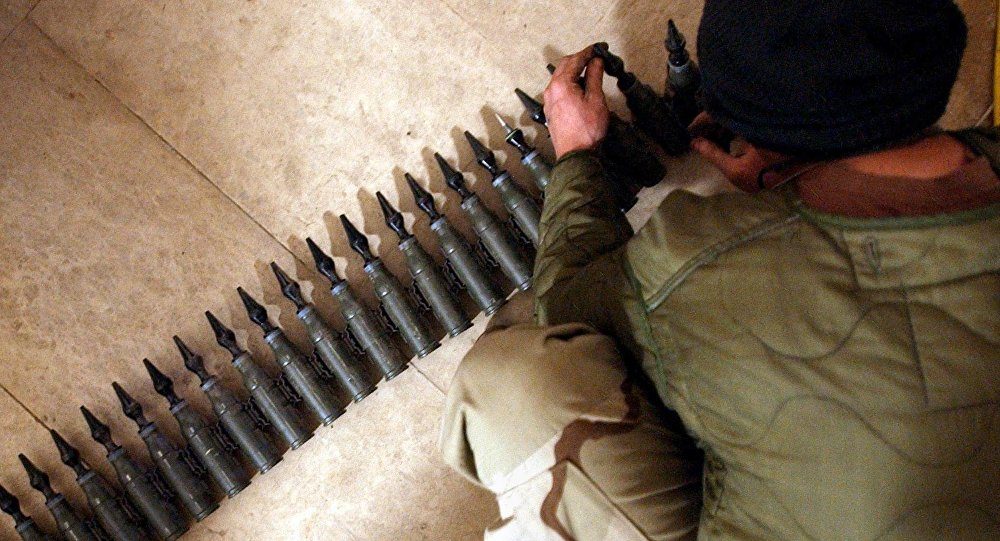
© AFP 2019 / STAN HONDA
A new study has drawn direct links between the US military's use of
depleted uranium in the Iraq War and congenital birth defects suffered by Iraqi children. Researchers examined the hair and baby teeth of dead Iraqi children near areas of heavy fighting as well as US military bases and found the radioactive element thorium - a telltale sign of uranium of the type used to make depleted uranium rounds.
Depleted uranium is a byproduct of the industrial process used to refine uranium-238 into U-235, which is more suitable for fuel in nuclear power plants. Composed of U-238 that cannot have further U-235 extracted from it, the matter is extremely dense - twice as dense as lead - and when fused with other metals, it makes for a very potent bullet. The US military
loves to use "DU" for piercing armor, but also for extra-powerful armor.
Thousands of rounds of DU were used against Iraqi positions during the first year of the Iraq War, which began in early 2003 after the George W. Bush administration, justifying its actions with false intelligence, launched an all-out invasion of the country, arguing that Iraqi President Saddam Hussein had a secret weapons program he intended to use against the United States.
"Once a depleted-uranium round strikes its target, the projectile begins to burn on impact, creating tiny particles of radioactive U-238,"
Common Dreams explained.
"Winds can transport this radioactive dust many miles, potentially contaminating the air that innocent humans breathe. This inhalation may cause lung cancer, kidney damage, cancers of bones and skin, as well as birth defects and chemical poisoning."Mozhgan Savabieasfahani, an independent researcher based in Michigan and a co-author of the study, looked at the hair and teeth of children from villages near Talil Air Base south of Baghdad, which US forces occupied during the counterinsurgency war that raged for almost a decade after the invasion as homegrown resistance to the US occupation grew. She found thorium in them, an element produced by the radioactive decay of U-238.
"We are basically seeing a depleted uranium footprint on these children," Savabieasfahani told
TruthOut in an interview. Her study, which will soon be published in the journal Environmental Pollution, found the children near Talil
had 28 times the amount of thorium in their bodies as did children in a control group far from the fighting and who weren't born with congenital disabilities.According to United Nations estimates,
the US fired up to 2,000 metric tons of DU at targets in Iraq in 2003 alone. The US also used the weapon against Iraq in 1991 during Operation
Desert Storm, and a limited number of rounds were also fired back at US forces by the Iraqi army.
However, that's not the only source of the element in Iraq: vehicles with DU-reinforced armor were brought into the country by the thousands by the Americans, as well as all sorts of aircraft and ground vehicles that used the rounds and for which the bullets had to be stored at US bases.
TruthOut notes that
much of this equipment wound up destroyed on the battlefield or rusting in junkyards across the country, leeching the radioactive chemical into the air and water, as well as into the pieces of metal likely harvested by locals to sell for scrap."What we see here, and what we imply with this study, is that we could see this very same scenario around every single US military base in Iraq," Savabieasfahani said. "The exposure of pregnant mothers to the pollutions of war, including uranium and thorium, irreversibly damages their unborn children."
Citing Iraqi government statistics,
MintPress reported in 2014 that
the rate Iraqis contracted cancer skyrocketed in the years after the US invasion, from 40 per 100,000 people per year in 1991 to 800 per 100,000 in 1995, to at least 1,600 per 100,000 in 2005. Iraqi doctors have long voiced concerns about the problem. A 2013 study by Dutch peace group
IKV Pax Christi found more than 300 such sites previously identified by the Iraqi government as contaminated with DU, and the US spent between $30 million and $45 million on cleanup at the sites. However, even as late as the 2013 study, observers still saw children playing on the waste heaps and collecting scraps for sale.
"The US must be held responsible and forced to clean up all the sites which it has polluted. Technology exists for the cleanup of radiation contamination," Savabieasfahani told TruthOut. "The removal and disposal of US-created military junkyards would go a long way toward cleaning toxic releases out of the Iraqi environment."
Comment: See also: Leaked Docs Reveal US And Saudi Arabia Supplying Terrorists in Yemen - Serbia files (Part 3)